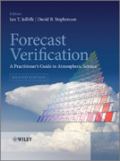
Forecast verification: a practitioner's guide in atmospheric science
Jolliffe, Ian T.
Stephenson, David B.
Forecast Verification: A Practioner's Guide in Atmospheric Science, 2nd Edition provides an indispensible guide to this area of active research by combining depth of information with a range of topics to appeal both to professional practitioners and researchers and postgraduates. The editors have succeeded in presenting chapters by a variety of the leading experts in the field while still retaining a cohesive and highly accessible style. The book balances explanations of concepts with clear and useful discussion of the main application areas. Reviews of first edition: 'This book will provide a good reference, and I recommend it especially for developers and evaluators of statistical forecast systems.' (Bulletin of the American Meteorological Society; April 2004) '.. a good mixture of theory and practical applications.. well organized and clearlywritten.. ' (Royal Statistical Society, Vol.168, No.1, January 2005) INDICE: List of Contributors xi Preface xiii Preface to the First Edition xv 1 Introduction 1 Ian T. Jolliffe and David B. Stephenson 1.1 A brief history and current practice 1 1.1.1 History 1 1.1.2 Current practice 2 1.2 Reasons for forecast verification and its benefits 3 1.3 Types of forecast and verification data 4 1.4 Scores, skill and value 5 1.4.1 Skill scores 6 1.4.2 Artificial skill 6 1.4.3 Statistical significance 7 1.4.4 Value added 8 1.5 Data quality and other practical considerations 8 1.6 Summary 9 2 Basic concepts 11 Jacqueline M. Potts 2.1 Introduction 11 2.2 Types of predictand 11 2.3 Exploratorymethods 12 2.4 Numerical descriptive measures 15 2.5 Probability, random variables and expectations 20 2.6 Joint, marginal and conditional distributions 202.7 Accuracy, association and skill 22 2.8 Properties of verification measures 22 2.9 Verification as a regression problem 23 2.10 The MurphyWinkler framework 25 2.11 Dimensionality of the verification problem 28 3 Deterministic forecasts of binary events 31 Robin J. Hogan and Ian B. Mason 3.1 Introduction 31 3.2 Theoretical considerations 33 3.2.1 Some basic descriptive statistics 33 3.2.2 A general framework for verification: the distributions-oriented approach34 3.2.3 Performance measures in terms of factorizations of the joint distribution 37 3.2.4 Diagrams for visualizing performance measures 38 3.2.5 Case study: verification of cloud-fraction forecasts 41 3.3 Signal detection theory and the ROC 42 3.3.1 The signal detection model 43 3.3.2 The relative operating characteristic (ROC) 44 3.4 Metaverification: criteria for assessing performance measures 45 3.4.1 Desirable properties 45 3.4.2 Other properties 49 3.5 Performance measures 50 3.5.1 Overview of performance measures 51 3.5.2 Sampling uncertainty and confidence intervals for performance measures 55 3.5.3 Optimalthreshold probabilities 57 Acknowledgements 59 4 Deterministic forecasts of multi-category events 61 Robert E. Livezey 4.1 Introduction 61 4.2 The contingency table: notation, definitions, and measures of accuracy 62 4.2.1 Notation and definitions 62 4.2.2 Measures of accuracy 64 4.3 Skill scores 64 4.3.1 Desirable attributes 65 4.3.2 Gandin and Murphy equitable scores 66 4.3.3 Gerrity equitable scores 69 4.3.4 LEPSCAT 71 4.3.5 SEEPS 72 4.3.6 Summary remarks on scores 73 4.4 Sampling variability of the contingency table and skill scores 735 Deterministic forecasts of continuous variables 77 Michel Deque 5.1 Introduction 77 5.2 Forecast examples 77 5.3 First-order moments 79 5.3.1 Bias 79 5.3.2 Mean Absolute Error 80 5.3.3 Bias correction and artificial skill 81 5.3.4 Mean absolute error and skill 81 5.4 Second- and higher-order moments 82 5.4.1Mean Squared Error 82 5.4.2 MSE skill score 82 5.4.3 MSE of scaled forecasts 83 5.4.4 Correlation 84 5.4.5 An example: testing the limit of predictability 86 5.4.6 Rank correlations 87 5.4.7 Comparison of moments of the marginal distributions 88 5.4.8 Graphical summaries 90 5.5
- ISBN: 978-0-470-66071-3
- Editorial: John Wiley & Sons
- Encuadernacion: Cartoné
- Páginas: 296
- Fecha Publicación: 30/12/2011
- Nº Volúmenes: 1
- Idioma: Inglés
